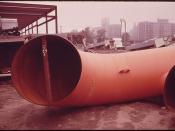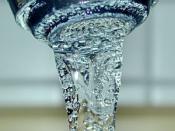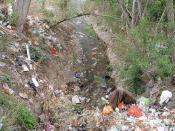Dangers of Water Pollution
Water pollution occurs when people overload the water environment with wastes. It's defined as contamination of streams, lakes, underground water, bays or oceans by substances harmful to living things. Water is necessary to life on earth. All organisms contain it, some drink it, and some live in it. Plants and animals require water that is moderately pure, and they cannot survive if their water is loaded with toxic chemicals or harmful microorganisms. If severe, water pollution can kill large numbers of fish, birds, and other animals, in some cases killing all members of a species in an affected area.
There are two types of water pollution; point source and nonpoint source. Point sources of pollution occur when harmful substances are put directly into a body of water (such as an oil spill). A nonpoint source is when pollutants enter the water indirectly through environmental changes (for example: fertilizer is carried into a stream by rain).
The major water pollutants are chemical, biological, and physical materials that lessen the water quality. These are some of the most important ones.
Petroleum Products - oil and chemicals from oil are used for fuel, lubrication, plastics manufacturing, and many other purposes. The petroleum products get into water by accidental spills from ships, tanker trucks, and leaky underground storage tanks. Many petroleum products are poisonous if ingested by animals and spilled oil damages the feathers of birds and the fur of animals, often causing death.
Pesticides and Herbicides - chemicals used to kill unwanted animals and plants may be carried into streams by rainwater. The chemicals in these that are not biodegradable can remain dangerous for a long time. When an animal eats a plant that's been treated with certain non-degradable chemicals, the chemicals are absorbed into the tissues or the...



Dangers of Water Pollution
Really good essay. If I was doing a project on Dangers of Water Pollution, I would definetly cite this essay
3 out of 3 people found this comment useful.